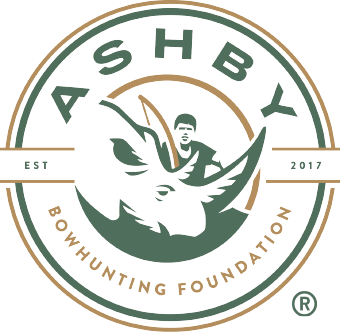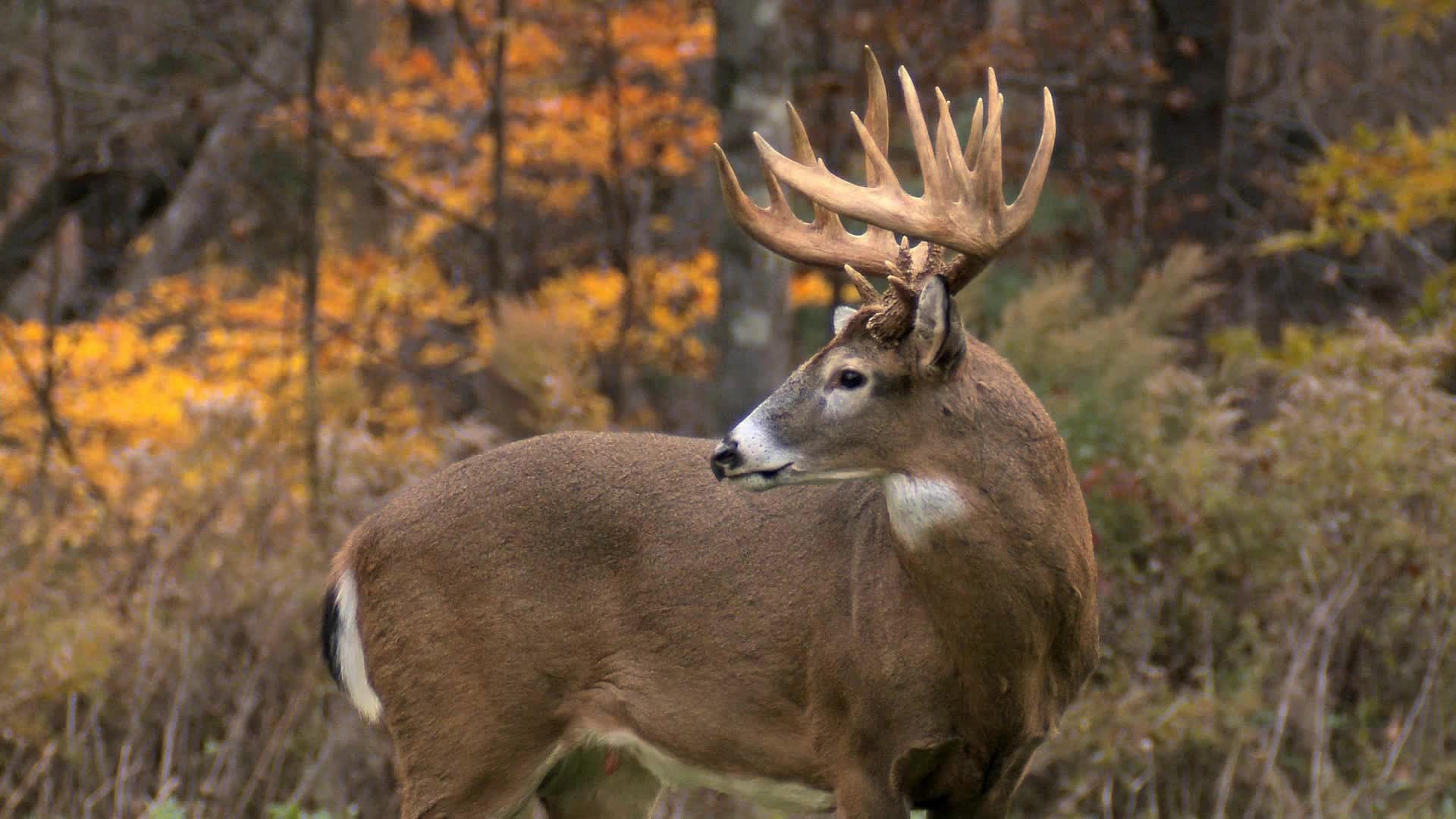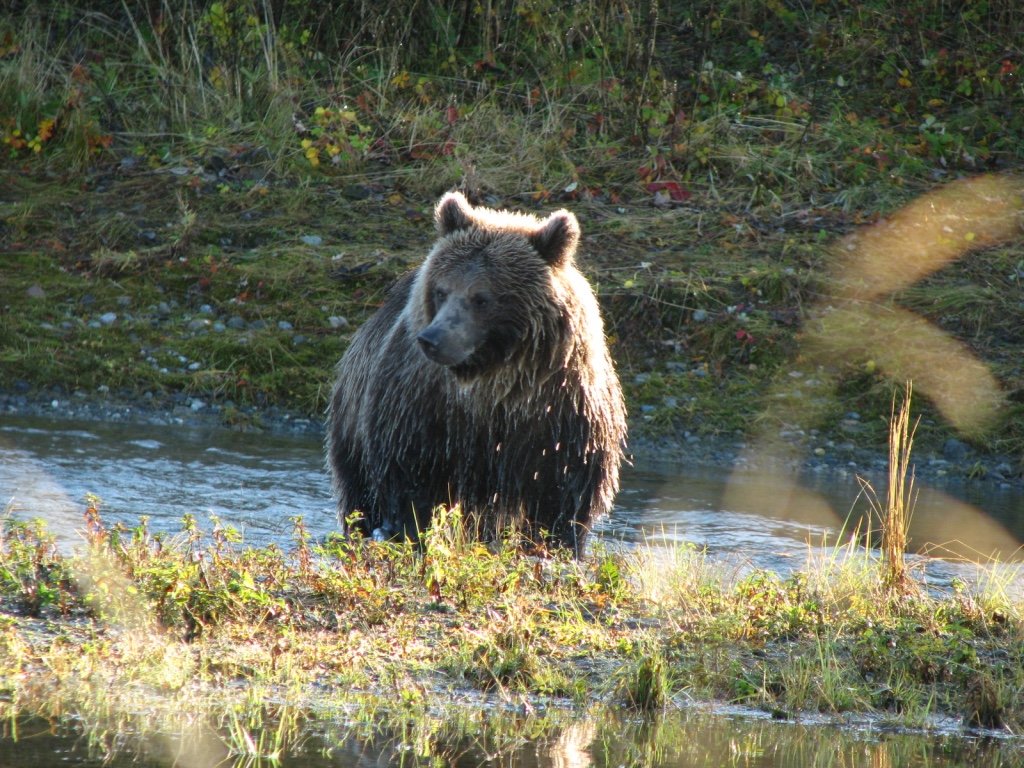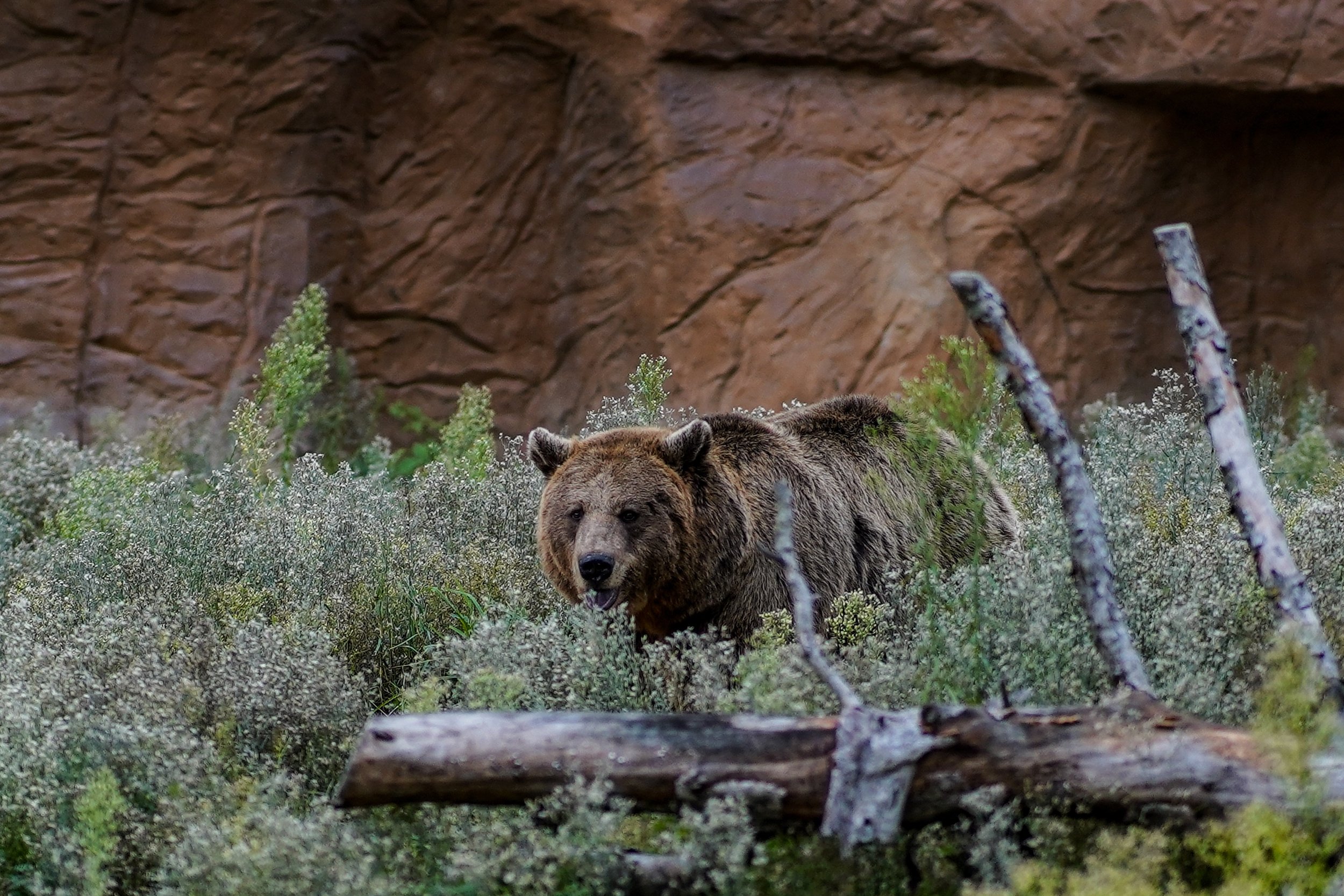Bull elk enjoying a wallow at 10,800 feet in the Rawah Wilderness of Colorado.
Ashby Bowhunting Foundation Newsletter
April 2025
President’s Message
Success: Sirius Tuffhead Dangerous Game, M300 Steel
Steel and Flour
Over the past few years ABF has noticed manufacturers touting more exotic steels than the typical 440C Stainless, i.e., D2, A2, K340, and others. While we applaud the use of steels that should have better impact resistance, we can’t help but look back at the data and notice the original Tuffhead 300 grain that was made from 420 Stainless (2022 testing) and tempered properly has outperformed everything to date except the newest Tuffhead Dangerous Game (2024 Focal Point Study). The focal point study on heavy bone was conducted in 2024 with the Tuffhead Dangerous Game, alongside the GrizzlyStik, made from K340 steel. While the Tuffhead did its job and held up structurally while splitting the bones, the K340 steel did not hold up structurally nor split the bone with blades chipping and the post twisting off.
Failure: GrizzlyStik 350 grain K340 Steel
Seeing this data reminds me of a quote from a noted Blacksmith Arnon Kartmazov: “Just because a knife is hand forged doesn’t mean it’s automatically better. Any chunk of steel is like a bag of flour. You can make a great cake or a nasty one. It depends on your skill. The knife exists only as a potential, inside that steel.”
Choose your chef wisely.
Good hunting and as always, have a nice day.
Rob Neilson
Donations
The Ashby Bowhunting Foundation is a 501 (c) (3) education and research organization. 100% of your donation will go to the Missions of Ashby Bowhunting Foundation. No salaries are paid by the Foundation. We realize there are many worthwhile organizations out there, and greatly appreciate your consideration and support.
Newsletter Tip
Bowhunting for elk or deer in September may put you in country where the streams to collect water may not be more than an inch deep. To avoid clogging your water filter with sediment, bring along a few heavy duty gallon size ziploc bags. To collect water, lay them flat facing upstream and let water slowly fill the bag. Let any sediment sink to the bottom and filter your water out of the bag. Your water filter will last much longer. Or you can skip filtering altogether and boil the water for several minutes. I prefer the Katadyn BeFree 1.0L Ultralight Collapsible Water Filter Bottle as there is nothing mechanical that will fail. Plus it filters water at least four times faster than any pump style water filter. If I’m filtering water for a large group I prefer the gravity style Katadyn Gravity BeFree 3.0L Water Filter. Over the years I’ve tried just about every water filter out there. These are by far the best filters I’ve used and the most reliable.
Events
→ May 3, 2025: Texas Hunter Education Instructor Association Conference - Workshop on Maximizing Arrow and Broadhead Terminal Performance
Ashby System Results - Bowhunter Interview with Dennis Wehling (Colorado)
Drawing of Dennis hunting pronghorn. Shari Fraker, artist.
1. How long have you been a bowhunter?
I started when I was about eight or nine years old which would have been in about 1959. My dad bought me my first bow at a rural “Five and Dime” in central Utah for $2.50. Bowhunting has been a lifelong journey that I am still able to enjoy well into my seventies.
2. Do you hunt with traditional equipment, compound, crossbow, or a combination of these?
I have hunted with, long bows, recurves and compounds. I saw my first compound bow in about 1969 when a neighbor happened to show me his new bow. I primarily hunt with compound bows these days.
3. What is/are your favorite animal(s) to hunt?
Dennis: I have been blessed to hunt most all western big game species; however, I would say my favorite animal to archery hunt has to be elk followed by antelope, deer and turkeys.
4. What is/are your favorite bowhunting method(s): stands, still hunting, spot and stalk, pure stalking, or other?
As I have grown older, I would say my favorite methods are calling and hunting small water sources or travel routes for elk. In my earlier days I primarily still hunted elk and or spot and stalk when the opportunity would arise. I am open to hunting whatever method would seem to provide my best chance of success while still maintaining a fair and ethical standard to the animal. I love to bow hunt spring turkeys and spot, and stalk fall turkeys while elk hunting. I also enjoyhunting antelope with my homemade antelope decoy.
5. What event(s) brought you to use Ashby-style arrow setups?
Lack of consistent results is what brought me to the Ashby Studies. Early in my bowhunting career I was blessed with much success, and it seemed that if I hit an animal, recovery was 100%. This early success led to forming a six-day bowhunting school here in Colorado with a fellow bowhunter. Our instructors were some of the who’s, who of Colorado bowhunting. At that time in the early 1980’s it seemed almost all bowhunters were shooting a standard set up ofabout 600 grains. Our school focused on shooting fundamentals, shot placement, scouting and all general outdoor skills. It was about then I first heard about the Dr. Ed Ashby Studies which always seemed to be followed by the statement it was for traditional archers, and it didn’t apply to compound bowhunting. Big mistake on my part was not doing my own research and I owe Ed an apology. At the same time there was a push to lighten our arrow systems to allow flatter trajectory since yardage was a guess based on feel, before rangefinders.
Arrows used throughout my hunting career, prior to finding the Ashby system.
Here is a photo of a few arrows primarily from animals showing what lead to my Ashby journey, which was poor penetration, broadhead failures and decreasing harvest rates. Arrows on the far right were my old 625 + or - grain arrows with long skinny 125 grain four blade Satellite broadheads. As I recall I had 100% recovery rate with that setup. Next, I thought a wider broadhead would increase blood trails, so I tried Rocky Mtn Supreme heads which were heavier (150 grains) and wider (1 -1/2”) and success started to drop. Soon, speed started to be a thing so I thought a faster arrow would help. So, I dropped to a lighter shaft (2215’s) but stayed with Rocky Mtn Supreme heads for a while. Next, I tried Zwickey Delta, Eskimo and Magnus broadheads, because they were supposed to penetrate better. Blades were only file sharp which was the thing back then. I started seeing more flight issues and sometimes I broke the welds and or bent the tips however I was lucky a few times. As carbon shafts came on the Market, I started trying lighter carbon shafts, but then I started to see deflections, broken shafts usually right behind the inserts. I stopped saving carbon shafts so only a few are in the pile. I then tried an Ulmer mechanical head one year, then Ramcats, followed by Muzzy four blade and lastly standard Slick Trick four blade. At first, I thought the failures were just me being unlucky, which was true sometimes, however I was seeing a lot of deflections, but then I would get a pass through that might miss ribs on both sides. Basically, I had gone from 625 grains to 550 grains, to just under 400 grains then back to about 425 grains and nothing was getting better which started me on the journey to find something better which led to the Ranch Fairy and the Ashby Bowhunting Foundation.
Bull elk taken with the Ashby system, a 50 yard recovery.
Next was the theory that increasing broadhead size would increase internal damage and improve blood trails. This all seemed to make some sense; however, I noticed my penetration and harvest rate was declining. Thinking these failures were all my fault I started to question every shot opportunity and was soon passing up easy shots for fear of failure. I began reflecting on past success and became convinced that I needed to recreate my old system with modern components, but I still didn’t really know why it had worked so well. I was struggling to find what I wanted when I stumbled upon the “Ranch Fairy” YouTube channel. Troy’s experience was much like mine with failures we hadn’t seen back in the old days. Following Troy’s advice I purchased “Ranch Fairy” test kit and decided to give it a try. That first year I shot a 625-grain arrow with 200-grain single bevel broadhead just to give it a try. That year my wife was wanting to go see some Colorado fall colors and tag along on a short elk hunt. On the first morning I was cold calling when a bull suddenly appeared. As he walked by at 8 yards, I shot him quartering in and was shocked at the bull’s reaction and my arrows complete penetration out the rear quarter into the ground. The bull jumped then just walked away to about 50 yards and stood until he fell over. It was at that moment that I was hooked on the Ashby system. I have never seen penetration like that nor such a short distance for recovery. The following year I increased my arrow weight to 709 grains and took a great bull at 45 yards quartering away again with complete penetration and the arrow stuck in the ground. The bull jumped at the shot only walking about 50 yards before falling over. Finding Troy and the Ashby studies has brought back my joy of bowhunting and given me the confidence to start shooting again. Seeing these results has been what I have spent a lifetime searching for. I want to thank Troy Fowler, Rob Neilson and Jeremy Johnson all for helping me along the way and Dr Ed Ashby for his lifetime of work to make us all more lethal and ethical bowhunters.
Check out Dr. Ed Ashby’s 12 Penetration Factors!
6. Could you describe your typical arrow setup(s) for hunting big game?
Victory RIP TKO 250 spine, 65 grain Titanium post and collar, 300 grain Tuffhead North American 3:1, four fletch feathers cut A&A style at 2.5”. Total arrow weight 655 grains and 28% FOC
Dennis: My typical arrow setup is for elk which is my largest target animal is somewhere between 650 and 710 grains. These are all 12-factor arrows minus tapered shaft. I am shooting 250-spine shafts with 3:1 Tuffheads and four fletch feathers as my standard setup currently. Typically, every year I work to improve my arrow setup as additional Ashby and or Ranch Fairy testing shows areas I could improve on.
7. Overall, what has been your experience using Ashby-style arrow setups?
Dennis and his son Derek at the Colorado Bowhunters Association Jamboree.
I would say my Ashby style setups have been like magic on elk. So far, my harvest rate has been 100% on elk which is much improved over any of my lighter setups. The first thing I noticed was all my shots have been pass-throughs on elk and lesser game. At the shot the elk jumped but don’t seem to realize what happened. It’s almost like they think a bird is what scared them. Following the jump, they seem to run a few yards then walk away slowly a short distance. So far, they have all stopped within about 50 yards and stood until they fell over. It seems my Ashby setup are much less stressful on the animals and the recoveries have been within sight which is a blessing.
8. Do you have any bowhunting tips you would like to pass along?
Over the years I have learned many lessons that I would like to share. The first one is the theory that fast long-range shooting is somehow the secret to bowhunter success. One of the popular websites has what they call a cold bow challenge, which is a test of bowhunters maximum effective range over three days. Hunters cannot practice once they start the challenge and can only shoot one arrow with a broadhead each day over three or more days, but only three total shots with no practice in-between. It is a great reflection of what bowhunters think is their maximum range and the reality of their actual ability. One hunter said his maximum range was about 50 yards but wondered how to score his shot when his expandable head bounced out of his foam target even though a small screw held the blades closed. The sad thing was most guys thought he should just be able to shoot an extra shot because that one didn’t count. It is a sad state of the current light and fast crowd not concerned about penetration and only consider score/hit as success. The challenge is great practice, but hitting the kill zone with an ineffective arrow system isn’t ethical when applied to actual bowhunting.
I would like to share the importance of mentors for new hunters and the importance of learning hunting skills on live animals. Experience is the best teacher. I started down the Ashby setup late in life and now look back and realize I could have doubled my harvest rate by simply following and adopting the Ashby study and the 12 penetration factors many years ago.
From the Field - Most Valuable Gear
A bull elk in a meadow that I learned was almost impossible to hunt, for good reason. The topography created an eddy that produced inconsistent wind most of the time.
Bowhunting typically requires penetrating one or more of the defense mechanisms of our quarry to be successful. In my early years of bowhunting I ate a lot of humble pie, not really knowing what I was doing or how to stack the odds in my favor. Simply being in the country that my quarry called home was obviously not enough. I would joke with fellow bowhunters that I was spending more time bow hiking, taking my bow for a stroll through the woods, than bowhunting. I was an eager learner, focusing on hunting whitetail deer in northwest Montana. If I had a dime for every white flag I saw as the deer bounded away, hooves pounding the ground or loud snorts to alert other deer of danger, I could have retired earlier.
By the age of nineteen, while attending the forestry school at the University of Montana, I met several bowhunters who shared the same passion and collectively had a lot of experience. Chuck Ondov convinced me to shoot a recurve bow after I complained I was having a hard time judging distance while hunting on the ground using my PSE compound without sights. He told me that the top limb was blocking my right eye, significantly reducing the value of parallax, two eyes focused on a single spot. With a compound bow, shooting off an elevated rest, I was forced to hold the bow straight up and down. With the recurve and eventually longbow and a homemade selfbow, I was free to cant the bow over and allow both eyes to focus on that single spot behind the front shoulder. Chris Gino and I spent a lot of time bowhunting gophers which dramatically helped me shoot instinctively by releasing an arrow on a brand new target every time versus a stationary bale of hay. And Steve Coale's deep experience as a hunter and trapper helped me realize there was a lot more I needed to learn to be successful.
A favorite homemade bow out of bamboo and ipe (Brazilian walnut). No handshock and quiet as an owl’s wing. A day of stump shooting.
As I started to apply what I was learning on the Bitterroot River, south of Lolo, Montana, I was slowly, and I mean slowly, getting better at harvesting whitetail deer. I'm not sure where I heard about tying frayed unwaxed dental floss off the front limb of my recurve bow. It might have been something I read from Gene and Barry Wensel or possibly Fred Asbell. But that changed everything. Rather than deciding where I was going to hunt as I was leaving my truck for the morning or evening, I let the air currents determine where and how I hunted. And I challenged myself to walk really slowly. By hunting with a recurve I was able to hold the bow with my left hand with the top limb out in front of me while I walked. I checked that dental floss constantly to ensure I was walking into the wind or at least quartering into it. Not only was I seeing more deer before they saw me, I was, more importantly, learning how four different types of air currents flowed over the area I enjoyed hunting.
Cold air drainage was typically in play if there was enough topography to allow cold air to move downslope, not only down the valley bottom but also off the hillsides draining into that valley. If the valley and slope was SE to SW facing, the cold air movement would end around 9:30 am on a high pressure day and switch 180 degrees to thermals. Now that I could anticipate this happening I did my best to keep my human scent from polluting the area I wanted to hunt by getting up on main ridges or finger ridges by that time and allow those thermals to blow in my direction.
Between 11 am and 1 pm the thermals would subside and be overtaken by the dominant wind. These changes were all dependent on a high pressure system when the air currents were more stable. I learned that during a low pressure system there was a lot of vertical lift of air and the air currents were unstable. Animals that depend on their nose defensively or offensively tend to hunker down during low pressure systems. Whenever possible, I avoided hunting during low pressure systems because the animals were already on edge.
As I explored new areas, I saw air current patterns repeating which helped me learn the navigation routes, bedding and feeding areas of deer and elk much quicker. That eight inch strand of frayed dental floss hanging off the front limb of my recurve, longbow or selfbow became the most valuable piece of hunting gear, by far.
Celebrating the WILD in wildlife,
David Neils
Doc’s Ramblings
Dr. Ed Ashby with a southern bushbuck
Doc's Ramblings
Now, I freely admit that I know very little about smartphones. However, I do know a good thing when I see it or, in this case, hear it.
A friend recently emailed me a video clip of him shooting his bow. In his video, he had placed his phone near the target, looking back towards him and shooting. The first thing that jumped out at me was how loud his bow sounded. What a valuable way to hear how loud your bow sounds to an animal! That prompted me to pass along a tip on quietening down a bow, taming string vibrations after the arrow leaves the bow if you prefer. As a starting point, make a recording of the sound your bow makes. Then, try dampening the bowstring's vibrations.
Before you go out and buy some expensive string silencers, here's something to try that generally works as well as those pricey string silencers the archery shop sells. Get some rubber bands about 3/16" to 1/4" wide (and bands made of natural rubber work better than synthetic rubber ones). Next, cut a couple open. You will need 2 pieces about 2 1/2 to 3 inches long. You want to attach these at the antinode points of your bowstring.
Start by tying one piece at each theoretical, primary antinode point location for a fixed vibrating string. An antinode is a point along a standing wave where the wave has maximum amplitude.
To locate the theoretical antinode points, measure the length of the string, including the full length for traditional bows or cable-to-cable on compounds. Next, place the top rubber band 1/4 of the string's total length down from the bowstring's top attachment. The bottom rubber band goes 1/3 of the bowstring's length up from the bottom of the bowstring's attachment. Those are the starting points you will want to use.
Tie each band around the bowstring with a simple overhand knot, and pull the knot tight. You can easily slide the rubber band up and down your bowstring. Now you'll want to set up that cell phone, or whatever you used to make the video and try another shot to see what your bow sounds like, compared to how it sounded without the rubber bands.
Next, it is time to locate the best placement for your particular bow. Fine-tuning is simply moving the rubber bands up or down your bowstring in about quarter-inch increments. The antinode points on your bow will probably be somewhere within plus or minus 1/2 inch of the starting placements. Placing the rubber bands at these points generally gives a maximum sound reduction, but not always. On some bows, the best placement for the bands is nearer 1/3 the string's length down from the top and 2/3 the string's length up from the bottom. These points often correspond to areas of significant vibration for the lower-order harmonics, and, on some bows, placement at these points maximizes the effectiveness of silencing the bow.
The placement of the rubber bands to get the most dampening effect of the bowstring's vibration should be near one or the other of these placements, one-fourth and one-third or one-third and two-thirds. You should make minor adjustments near these two sets of placements. Just like tuning arrows, you have to go methodically through the process of making incremental adjustments in the rubber band placement and check each change's effect on the bow's sound. Keep a record of each placement you try by measuring the placement from the bowstring's top and bottom.
Once you locate the exact antinode points, the point giving the most reduction in sound, you can also experiment with exactly how long each end of the rubber band is. You can try splitting the ends of the rubber bands into "fingers." On bands that are 3/16-inch wide, I usually split each end down the middle for about a one-inch distance, and on ¼-inch wide bands, I divide into three "fingers." Just use sharp scissors to cut the splits. These splits add an additional dampening effect to the string's "after arrow launch" vibrations.
For temporary (or permanent) use, you can leave the rubber bands tied to the bowstring with that simple overhand knot. If you pull the knot tight, the rubber bands will stay in place fine. It is a good idea to measure and record the exact placement for periodic checks of placement and for future reference.
The rubber bands will probably slow your bow down from 1 to 5 or 6 feet per second. If you use sights on your bow, after you get the rubber bands installed and tuned check your sight settings to see if you need to make an adjustment.
That should make enough difference in the sound of your shot that you can clearly hear the difference on a video. You are looking for a dull "thud," more like a falling heavy limb hitting the ground.
Attention to this small detail can often make the difference between a successful shot and one "the animal votes against." It is a big reason I prefer to hunt with a longbow. A longbow can be made more silent than any other type of bow. Drawing from my experiences with approximately a thousand bowhunted animals, I'll take a slow-shooting, silent bow over a faster, louder one every time!
Good hunting, my friends,
Dr. Ed Ashby

















